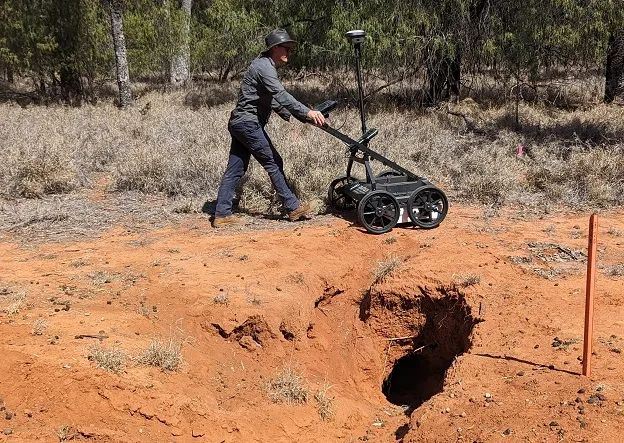This article was first published on SpatiaSource, July 16, 2024, "Case study: Locating wombat burrows with GPR".
The IDS Stream DP ground-penetrating radar has proven vital in efforts to conserve the endangered northern hairy-nosed wombat.
Gold Coast-based Subsurface Mapping Solutions (SMS) was founded just over three years ago by managing director, Andrew Watson. The company, which specialises in underground service location — primarily looking for utilities such as communications and power — recently became one of the first in Australasia to purchase the IDS GeoRadar Stream DP ground-penetrating radar (GPR) from C.R. Kennedy. “We’ve ventured fairly deeply into 3D multi-array GPR mapping, which is how we ended up on the wombat project,” said Andrew.

The wombat project is a vital conservation project being run by the Australian Wildlife Conservancy (AWC) at a sanctuary in St George in southern Queensland, about six hours’ drive from the Gold Coast. The wombats in question are the critically endangered northern hairy-nosed wombat, the world’s largest burrowing herbivore. This large marsupial once roamed all across Queensland and northern NSW but at one stage had dwindled to a population of just 35. Conservation efforts have raised to a little over 300, with around 15 thought to be present at the St George site.
GPR work to map the burrows had been attempted many years ago but failed due to the inadequacies of the equipment then available. Recently, the AWC became aware of SMS’s new capabilities with the Stream DP, contacted them and asked if it would be feasible to use it on the burrows.
“It was a bit of an unknown to be honest when we first went out there, but the results turned out to be fantastic,” said Andrew. “GPR is generally limited by soil conditions, but these machines have just a little bit better technology that can help push the signal deeper into the soil.”
The Stream DP’s large multi-channel array — 30 channels in double polarisation; 19VV plus 11HH — enables accurate 3D detection of underground assets and voids in a single scan. It features Equalized scrambled Technology, or EsT, which enables it to exploit the entire radiating performance of the antenna for full control of the GPR signal, whilst at the same time performing noise rejection and capturing both lower and higher frequencies for extended depth range and an ultra-high resolution. For positioning accuracy, it has an integrated encoder and PPS and a user-fitted external GPS and TPS.

Designed for easy transportation, the Stream DP’s light weight (maximum 20 kg per part) and compact size means that it can fit inside a standard vehicle and be assembled and deployed by a single person. It’s designed to handle a variety of scenarios from asphalt (with pivoting wheels) to rugged ground (terrain wheels) and has a scan swath width of 83 cm.
“It’s pretty awesome,” says Philip Byrne, C.R. Kennedy’s National Sales Manager, GIS and Detection, Survey Division. “A lot of survey companies are getting into sub-surface detection — they see the benefit. And Stream DP is just so far ahead of the other systems in the market.”
“GPR generally is quite complex to read,” he adds. “But with 3D GPR, because you’re getting more data, you can form a tomographic view — it just makes your data a lot more visible and easier to decipher.”
The Stream DP has an in-built screen that gives you a real-time view of what you’re scanning, and SMS operates it with a Leica Geosystems Leica GS18 T GNSS RTK rover mounted on top, so everything’s georeferenced to centimetre accuracy.
A level above for work below
SMS ended up scanning half a dozen burrows, focusing on mapping out the networks to find out how far they reach. According to Andrew, while it was a very unique project, the principles were the same as any other underground locating effort — they were still looking for the same sort of signals and targets via the machine, in this case cavity or void space detection.
So could the job have been done with a standard GPR?
“Not as well,” said Andrew. “It has been tried before with other technology and wasn’t successful. You definitely wouldn’t be able to produce the same reports and the same imagery. I always say that the Stream DP is unparalleled, unmatched. Other providers like to say their equipment can do the same thing, but I’ve got six different machines and none are as good as the Stream DP.”

When it’s not being used to map wombat burrows, Andrew says it’s a great machine for utilities work and other uses. “It’s particularly good for void detection,” he adds, with sinkhole investigation being one of the latest applications. “We’ve been using it on highways where they’re having issues with patches in the road that keep failing, so we do investigations to try to see what we can find.”
So how would Andrew sum up 3D GPR and the Stream DP in particular?
“I think people just assume that GPR technology is not changing, but it is. It didn’t go anywhere for 10 years then suddenly it’s moved ten years in the last 12 months. The technology is definitely improving,” he said.
“I’ve used GPRs for 15 years and I’ve never used anything else like the Stream DP. It’s definitely a level above everything that’s been out in the market before.”



